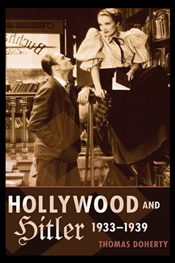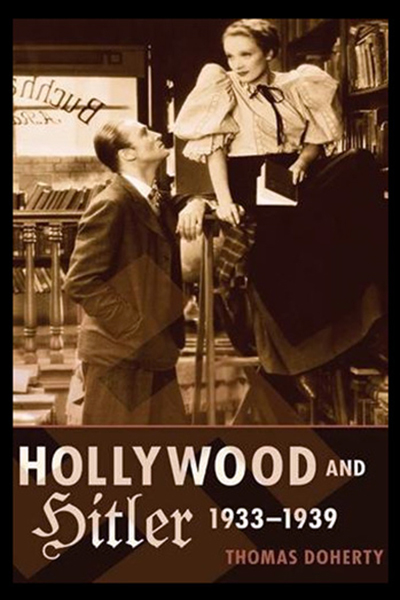
- Free Article: No
- Contents Category: History
- Review Article: Yes
- Article Title: Complicated dealings
- Article Subtitle: Two books on Hitler’s impact on film and music
- Online Only: No
- Custom Highlight Text:
For all their differences of subject matter and approach (not to mention style), both of these studies can be seen as belonging to the category of what might be termed archaeological history. That is, they are concerned with retrieving and bringing to the surface a gallery of characters and set of important stories and connections which have been either suppressed or ignored.
- Book 1 Title: Forbidden Music
- Book 1 Subtitle: The Jewish composers banned by the Nazis
- Book 1 Biblio: Yale University Press (Inbooks), $39.95 pb, 376 pp
- Book 2 Title: Hollywood and Hitler
- Book 2 Biblio: Columbia University Press (Footprint), $54.95 hb, 448 pp
- Book 2 Cover Small (400 x 600):

- Book 2 Cover (800 x 1200):

- Book 2 Cover Path (no longer required): /images/August_2014/hollywood%20and%20H%20-%20colour.jpg
The composers and musicians whom Goebbels and his musical Gauleiters set out to obliterate were notable for their diversity: they included not only High Modernists and Schoenberg disciples, but also writers of cabarets and revues, film and theatre scores, as well as popular song-and-dance numbers. Their work appealed to, and was programmed for, diverse audiences: and as long as they offered commercial rewards to their publishers and/or producers, the latter were more than happy to promote them, and sing their praises both in public and private.
Thus, a further disconcerting feature of Haas’s study is his alertness to the way these business figures were only too ready to sing from another sheet when the Nazis began their campaign against Jews, jazz, and anything close to the jollity associated with styles like ragtime or the Charleston. As he points out:
Korngold’s [the composer Erich Wolfgang Korngold, a high profile figure prior to 1933, who subsequently established himself as a major film composer in Hollywood] publisher Schott had earned enormous sums from composers banned by the Third Reich and had every motivation to resist Nazi efforts and intervene in cultural policy. Instead, Schott went over to the other side – while writing cringing letters to its ‘non-Aryan’ composers […] Both the Strecker brothers (they ran the firm) were sympathetic to National Socialism […] brother Willy had written to Stravinsky in April 1933: ‘This movement has so much that is healthy and positive about it … a welcome cleaning up has been undertaken … in an attempt to restore decency and order.’
It is hard to decide which is worse about the behaviour this paragraph reveals: the hypocrisy or the fact that so soon after the Nazis came to power a supposedly cultured and intelligent figure on the musical scene was already sounding like someone who has assimilated all the vicious excesses of Wagner’s ‘Judaism in Music’ (1850)along with Goebbels’s language and attitudes.
Not the least of the merits of Haas’s study is his attention to the wider historical context he provides, along with the attempt to relate this to the complex of issues and personalities that are the major focus of his attention. Inevitably, however, this leads to some awkwardness in the handling of chronological details, resulting in the familiar problem of too many trees and a wood that at times seems impenetrable.
 Joseph Goebbels (German Federal Archive)
Joseph Goebbels (German Federal Archive)
Moreover, while his awareness of the significance of Heinrich Heine is apposite, someone at Yale should surely have noted that, although Haas’s insistence on providing his own translations from the original German is, with some qualifications, acceptable, the same does not apply to his efforts at translating passages from Heine’s poetry. These are so clumsy and insensitive that the reader unfamiliar with Heine’s tone and characteristically supple and precise language might be pardoned for thinking he was some bizarre German combination of Browning at his most impenetrable and Tennyson at his most rumty-tum.
Opening his work with eight stanzas from Heine’s extended satirical/historical exposé of Germany, Germany: A Winter’s Tale may have seemed to Haas a good idea, but I suspect I am not the only one to find stanzas like the following not just obscure but close to bathetic doggerel:
Of Saint-Just’s words, I know quite well
Once uttered on charitable boards
That sore afflictions, with rose-oil and
musk
Won’t work to cure the hoards
It is Heine, after all, who was responsible for the earliest prophetic anticipation of what was to occur in his native country, when he wrote in his Almansor (1821): ‘There, where people burn books, they will also burn people.’ Sadly, over the later pages of Haas’s account, the reader can almost imagine the hovering flames that eventually consumed so many of the figures whose names and works he cites: Pavel Haas, Viktor Ullmann, and Hans Krasa, to name but three.
In one sense, Thomas Doherty’s examination of the connections and tensions between the American film industry and Hitler has a less depressing story, or series of stories, to tell. Many of the names that crop up in Haas’s pages also appear as incidental (and surviving) players in the complicated scenarios involving producers, agents, script writers, actors, and activists on the American side, and consuls, official censors, distributors, bureaucrats, and party officials across the ocean. Composers such as Korngold, Franz Waxmann (winner of two Oscars and twelve Academy Award nominations), and Friedrich Hollaender (composer of the score for The Blue Angel (1930), and, subsequently, of scores for numerous Hollywood films) escaped the fate of so many of their fellows and managed – though often not without considerable cost to their sense of self and their health – to carve out new careers for themselves in an industry which had already enabled several fellow émigrés from Germany (including directors, cameramen, designers, and technicians) to establish themselves as major figures in the industry.
Doherty is not so concerned with telling tales of individual survival and struggle against the odds, as with teasing out the complicated network of dealings between studio owners, directors, distributors, the Hays and Breen Offices, and the hitherto largely shadowy figure of the German consul in Los Angeles, Georg Gyssling. Many of the most compelling details in his study relate to what he has uncovered in the course of his research into this Nazi bureaucrat’s unrelenting attempts to persuade studios, actors, and producers to take a supposedly ‘neutral’ attitude to what was happening in Germany.
 Young Dorothy Parker
Young Dorothy Parker
Doherty provides several instances of Gyssling stopping at nothing to block any closer examination of life under the Nazis, while across town the wretched Will Hays and the self-righteous ‘stern Irish Catholic Joseph L. Breen’ were intent on doing as little (or as much) as possible to maintain the codification of a ‘see-no-evil, speak-no-evil, hear-no-evil policy toward any regime on the planet’.
To balance this out, he also addresses the role of organisations such as the Hollywood Anti-Nazi League (HANL), an organisation initially set up by the writers Donald Ogden Stewart and Dorothy Parker, and supported by such dissimilar figures across the political and religious spectrum as John Ford and Irving Thalberg, Fredric March and James Cagney. For reasons best known to himself, Doherty persists in describing its activities in a tone which veers between the patronising and the tiresomely semi-facetious. While he correctly characterises Prince Hubertus zu Loewenstein as a ‘fearless anti-Nazi activist’, the next minute he writes of a lecture he delivers in April 1936 as taking place in ‘the swank dining room of the Victor Hugo Café’, where a ‘mixed congregation of Jews, Catholics and Popular Fronters paid upwards of $100 a plate’ to hear the ‘Old World aristocrat’ being ‘guaranteed a friendly reception from the local version of royalty’.
At times, Doherty’s attempts at humour are so oddly miscalculated that one begins to wonder whom he sees as the real problem in the 1930s. In one sentence he manages a sneer not just at the Broadway left-wing satire (and hit) Pins and Needles (1937), but also at Joris Ivens’s unforgettable documentary on the Spanish Civil War, The Spanish Earth (1937), before snidely summing up the HANL supporters as ‘ready to man the barricades with a night out on the town in the service of uplifting left-wing entertainment’. All this above a photograph of Herbert J. Biberman and his wife Gale Sondergaard attending a film première, with the label ‘white tie and tail activism’. It might have been more apposite to add a footnote pointing out just how consistent their political and artistic stance remained, taking in one of Hollywood’s greatest protest films (Salt of the Earth, 1954) and their falling foul of Senator Joseph McCarthy.
Postscript: since the appearance of Doherty’s book, Australian scholar Ben Urwand’s The Collaboration: Hollywood’s Pact with Hitler (Harvard University Press, 2013) has proposed that the connections between the film industry and Nazi Germany were even more dubious and compromised than previously supposed. Urwand’s arguments have generated heated controversy, including an extended discussion in the pages of the New Yorker by their film critic David Denby, who has spoken of the ‘half-boldness, half-cowardice and outright confusion that marked Hollywood’s response to Nazism and anti-Semitism in the 1930s’.


Comments powered by CComment